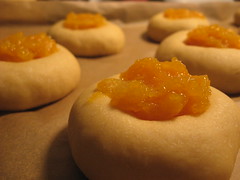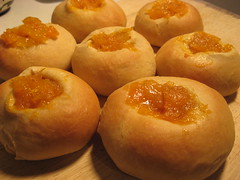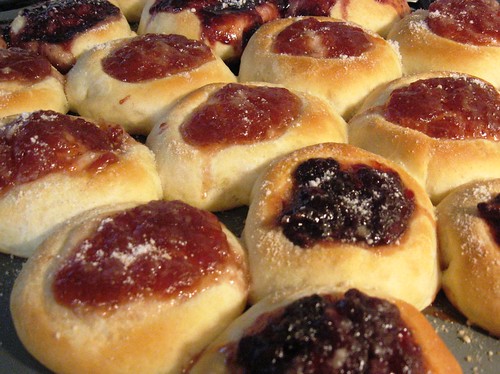Back in the fall I promised my niece-in-law that I would make kolaches for her birthday at the end of November. Which I did, using the recipe from the point of departure. They were OK, but not quite right. Too dry, a little doughy and the flavor was not quite the same. Wait a minute, you say, not the same as what? What the heck are these kolaches of which you write?


Right smack in the middle of Texas there's an area that was populated by people of Czech descent. Well, a bunch of Germans, too, but right now we're interested in the Czechs. They brought a number of traditions from the home country that have worked their way into local culture, most prominently the sweet roll that makes a true Texan's heart do a little extra thump---the kolache. When I was little, the ladies from the Catholic church in Ennis would come up to our church in Dallas to fundraise by selling home-baked kolaches to the big city folks. We didn't get quite as excited as we would for Christmas that weekend but it was right up there with, say, Easter. Mom would buy six dozen and freeze five of them to be brought out for special occasions during the year. We got to eat one box that morning. Now, you have to realize that there are nine kids in my family. Add two parents and that meant that we each only got one kolache. And I still remember those five or six bites as a highlight of my year.
After a couple of my brothers moved to Austin to go to the University (no need to qualify which university in Texas) our kolache supply got a little steadier. Anyone who made the drive between Dallas and Austin was required to stop in West, Texas (the name of a town, not a region that is in central, not west, Texas) and pick up a couple dozen. It was a regular enough occurrence that we could request certain fillings instead of just grabbing whatever was available. I always went for apricot first, cream cheese second. Or maybe prune. And then, I grew up. Moved away. Lost my source and only ever got a kolache fix if my visits to Dallas happened to coincide with an Austinite's. Joined that community of expat Texans who could only dream. Now and then I'd find a bakery that claimed to make them but they were never anything close to what I remembered. You know, if it's not right, it's just not right.
Now you probably think I'm crazy, just wierd to feel this way about a pastry, but I am not alone. My niece who requested them for her birthday isn't even a Texan, just married to one. When I went looking for a recipe on the internet, the passionate postings about dough and fillings were everywhere. They all seemed to point one direction, however. The recipe posted on The Homesick Texan blog seemed to be the place to go for the real thing. There were 138 comments on the post that all say pretty much the same thing, "Oh my god these are amazing, just the way I remember them." So I used her dough recipe exactly. I subbed in some other fillings since I was out of apricots but that's not important. It's the bread that matters. And now there are 139 comments on that post including mine which says, "Oh my god these are amazing, just the way I remember them."
I'm not going to reprint her recipe. You can go see it for yourself. I will just tell you that I found I had to bake them a little longer than her timing states, more like 20-25 minutes. It may just be that I need to check my oven temp. There are some tiny details that she leaves out that make them even more perfect like you should put them close enough together on the baking sheet so that the oven spring makes them just kiss each other and you wind up with a slightly squared off, not perfectly round finished product. I found the Posypka recipe needs either more butter or less flour/sugar to make it clump properly. She only includes a recipe for apricot filling but it seems more authentic to have a variety so I made three kinds. I used some Trader Joe organic strawberry preserves for some which, while cheating, still came out well. I took some plum conserve my brother made from his home-grown red plums, drained out most of the liquid and mashed up the plum bits. Those, too, were pretty successful. And I really wanted some raspberry ones so I just tried some raspberry jam I had in the fridge. This was way too watery and made a mess on the cookie sheet. They also got the 'best taste' vote from all my testers so I'm going to work on how to make a drier version next time. I also have a request for the cottage cheese/cream cheese filling from my nephew. Can't wait to try it.
